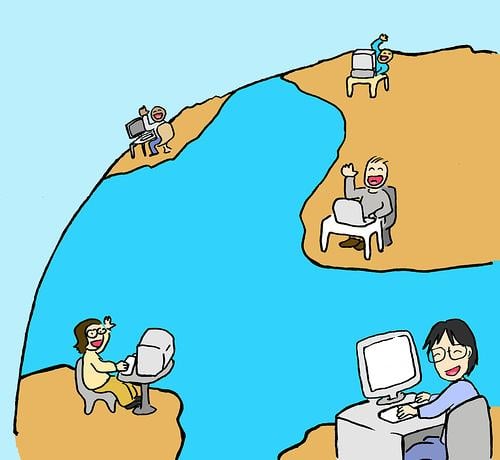Published on
We All Learn

The following is an excerpt from Curtis Bonk’s most recent book, The World Is More Open: An Extension of “The World Is Open: How Web Technology Is Revolutionizing Education.” Visit the book homepage.
The world is open and now we all can learn. In a global world, technological changes can impact individuals not just in Athens, Greece or in technological accelerators like Korea, but can quickly spread to educational systems in many countries and cultures. It is impacting educational systems as well as economic ones.
A few years back, Thomas Friedman* argued accurately pointed out that the world is flatter economically. He detailed 10 trends that backed up his claims. In this book, I will detail 10 learning technology trends that make the world increasingly open for education. These 10 trends spell the word “WE-ALL-LEARN.” Friedman discussed a triple convergence that is in his words is “turbo-charging” this flattening process. This triple convergence involves a flattened playing field, new players within that playing field, and a change in business management processes. For example, after centuries of vertical, authority-driven business hierarchies, there is now a more horizontal form of management structure in business. The new players he is referring to includes those in India, China, and Eastern Block European countries. And the new playing field is highly apparent in the collaborative technologies that enable colleagues and employees to come from anywhere in the planet.
So, those who have been immersed in different versions of Friedman’s book and have come to grips with most or all of his 10 trends should have the basic building blocks for understanding the more open educational world. It is not a one-to-one match, however. The open educational world, however, is about a different set of “p’s;” namely, pages of content, piping for that content to run through, and a participatory learning culture. Instead of economic might fostered through online technology, this book is about intellectual might.
To help make sense of the 10 learning technology trends, I offer a simple-to-learn acronym, “WE-ALL-LEARN.” As opposed to flatteners, I label these as openers. After three relatively brief introductory chapters, each of the 10 openers is discussed. These openers include the emergence of online and blended learning, collaborative technology, digital books, open source software, and wireless and mobile learning. A series of resources, examples, and research data is embedded in each one. The stories are included to make the content come to life. The associated book is filled with much more content and stories.
Ten Openers: (WE-ALL-LEARN)
- Web Searching in the World of e-Books
- E-Learning and Blended Learning
- Availability of Open Source and Free Software
- Leveraged Resources and OpenCourseWare
- Learning Object Repositories and Portals
- Learner Participation in Open Information Communities
- Electronic Collaboration
- Alternate Reality Learning
- Real-Time Mobility and Portability
- Networks of Personalized Learning
The WE-ALL-LEARN model is intended to help one make sense of these changes. Advances in technologies for learning can be into one of these 10 openers. This should reduce tension and frustration teachers, students, parents, administrators, government officials, and other feel with each new technology announcement, fad, and exciting invention. There will, of course, be other such frameworks that will emerge. There will also be new openers that can nurture education. This is simply one framework for the present learning times. Given the fact that billions of people who previously had quite limited access to education will soon be able to access learning materials through the Web from their mobile phones and computers, it is vital to make sense of their learning opportunities.
You will likely have experienced many of these trends on one or more occasions. For instance, one trend documented in this book is the sudden movement toward free and open content using the Web of Learning. Another is the offering of classes in both fully online as well as more blended modes. A third is when learners can seamlessly collaborate with other learners in any region or locale. And a fourth one relates to the fact that the learning worlds that students can enter are not just live classroom settings but can also be digital or simulated ones. These four learning opportunities are among the 10 learning trends documented in this book. When you read this book, keep in mind that all 10 are coalescing today to offer formal and informal learning opportunities at any moment for any person.
Book Goals and Audiences
Given the accelerating changes we all are experiencing, this book should be of value to everyone with education or learning needs or aspirations in the early part of this century or anyone interested in emerging trends in education in general, especially that related to technology. Accountants to teachers to librarians (or cybrarians) to government officials to corporate trainers to field archaeologists should find different parts of it of value. With dozens of embedded stories, the book leans more toward practice than to theory. However, as a former educational psychologist, I am hopeful that theoreticians can find some valued concepts and principles within these anecdotes.
* Thomas L. Friedman. The World is Flat: A Brief History of the Twenty-first Century (New York: Farrar, Straus, and Giroux. 2005).
Author Perspective: Educator



